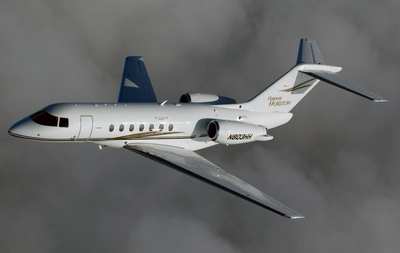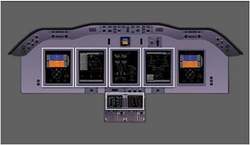Horizon "Beating Preliminary Performance Estimates"
 You know the old saying about how
"it ain't bragging, if it's true?" Well, it seems that Raytheon has
a lot of good news to impart with their revelations concerning how
well the Hawker Horizon is doing in meeting AND beating its
performance numbers.
You know the old saying about how
"it ain't bragging, if it's true?" Well, it seems that Raytheon has
a lot of good news to impart with their revelations concerning how
well the Hawker Horizon is doing in meeting AND beating its
performance numbers.
The 700 hour test program has completed 50 percent of flight
tests, using three test aircraft. All developmental testing
throughout the normal airspeed/altitude flight envelope has been
completed, and structures, avionics, software and electrical
systems are frozen for production.
"The Hawker Horizon is proving its design in flight test and
exceeding estimates in critical areas," said David Riemer, Vice
President - Product Development and Engineering. "Aerodynamically,
this is a very 'clean' aircraft - the wing design, propulsion
system and composite fuselage are validating all of our design
choices."

Raytheon tells ANN that the super mid-size Hawker Horizon
business jet is exceeding estimates in the following areas:
- Range: The estimate for six passengers at high-speed cruise of
0.82 mach is 3,100 nautical miles. Current testing shows the
aircraft will fly 3,147 nautical miles under these parameters.
- Take-off field length: The Horizon's stall characteristics,
which affect take-off field length, are about four knots less than
originally predicted. The guarantee is 5,250 feet; but based on
testing to date, the current estimate is less than 4,900 feet.
- Climb performance. The Horizon is providing
better-than-expected performance with an anticipated climb from sea
level to 37,000 feet in just over 13 minutes - as opposed to 15
minutes originally estimated.
"The more we test this aircraft, the more confident we become,"
said Riemer. "We're looking forward to first deliveries next
year."

In other tests, the Hawker Horizon successfully completed:
- Proving flight of its advertised trans-Atlantic (3,400nm) range
capability. In June, the Horizon departed Beech Field in Wichita
and flew to Los Angeles, north to Seattle, and returned to Wichita
after 7.6 hours. En route to Los Angeles, the super mid-sized
business jet was cleared to 45,000 feet, where it flew most of the
remaining legs. Average speed was 0.77 mach - slightly faster than
the Horizon's 0.75 mach long-range cruise speed -- while the crew
conducted tests of the fuel system, autopilot, weather radar and
navigational equipment.
- Critical dive tests to Mach 0.91, which is 15 percent above the
Horizon's top speed of Mach 0.84. The high-speed tests are designed
to demonstrate that the aircraft is fully controllable and flutter
free at a speed that significantly exceeds its normal operations
limit.
- Icing flights behind a tanker, demonstrating correct operation
of the wings and windshield. The tail was completed earlier in
wind-tunnel tests. Final tests will be done in natural icing
conditions, and the aircraft will deliver will all icing
certifications.
- Laboratory burn tests which confirmed the engine pylon and beam
for survivability under a 2000-degree (F) flame for 15 minutes in
the engine compartment.
- The first interior fitting, which revealed a precise fit inside
the composite fuselage that will reduce the amount of time required
for installation.
 Brad Hatt, President and General
Manager of the Hawker Division noted that, "Flight tests are
proving its exceptional performance, and the Honeywell Primus Epic
avionics will offer the most integrated flight control package of
any super mid-size business jet."
Brad Hatt, President and General
Manager of the Hawker Division noted that, "Flight tests are
proving its exceptional performance, and the Honeywell Primus Epic
avionics will offer the most integrated flight control package of
any super mid-size business jet."
The Horizon fuselage is constructed of advanced composite
technology. Built in three sections, the Horizon fuselage features
a 72-inch stand-up cabin and 77.5-inch width. A flat floor runs the
entire length of the aircraft, leading to a large baggage area. The
baggage compartment is accessible on the ground through an exterior
door or during flight through the cabin. The Hawker Horizon will be
delivered with a comprehensive customer support package and will be
served by Raytheon Aircraft's global network of company-owned and
independent service centers.
 Unfortunate... ANN/SportPlane Resource Guide Adds To Cautionary Advisories
Unfortunate... ANN/SportPlane Resource Guide Adds To Cautionary Advisories ANN FAQ: Turn On Post Notifications
ANN FAQ: Turn On Post Notifications ANN's Daily Aero-Term (04.29.24): Visual Approach Slope Indicator (VASI)
ANN's Daily Aero-Term (04.29.24): Visual Approach Slope Indicator (VASI) ANN's Daily Aero-Term (04.28.24): Airport Marking Aids
ANN's Daily Aero-Term (04.28.24): Airport Marking Aids ANN's Daily Aero-Linx (04.28.24)
ANN's Daily Aero-Linx (04.28.24)





